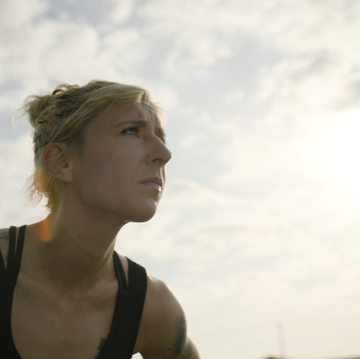I’m assuming neither of you has crushed a car before?” Tony Borglum, the owner of Drive a Tank, asks me and my friend Gina.
We shake our heads. I’m nervous. We’ve been driving armored military vehicles all morning, but the watershed moment of the two-day program in Kasota, Minnesota, arrives before I feel ready.
“As you approach the car, stay on the throttle,” he instructs. “You’re going to have to fight every impulse in your brain, but remember: Do not lift your foot off the pedal.”
When we booked our girls’ trip months ago, we’d envisioned blowing off everyday stress by driving decommissioned tanks through the wilderness. But by the time the day arrived, the trip felt less than celebratory. My fiancé, Davey, had died in an accidental drowning five weeks earlier, and the trip would mark my first reunion with Gina, a close mutual friend whom we’d tapped to officiate our future wedding. It would also mark my first effort to return to normalcy following a prolonged bout of delirium.
In the early days, after I reported Davey missing while he was out riding a motorcycle, I channeled my frazzled energy into publicizing the search efforts in media interviews, calling the police for updates, and reading hundreds of messages that poured in from around the world. Some sought to provide comfort, while others proffered bogus tips that Davey had been spotted in some corner of the world, raising my hopes each time despite the growing impossibility.
When I wasn’t running on waning adrenaline, I retreated into an ever-shrinking shell of myself. I relied on a bulwark of friends to feed me, clothe me, and drive me around town. They patiently listened to me voice my disbelief repeatedly, and they sat sentry with me day and night. In those weeks, I couldn’t bear even a minute alone—a disorienting urge for an avowed introvert.
As my grief razed me, I saw Davey’s face—both in pictures and imagined in strangers—everywhere. I lost 20 pounds while wearing the same beige sweater. I felt too dazed and erratic to trust myself to get behind the wheel of a car, let alone a tank.
Though I wanted to cancel the trip to Minnesota, I didn’t have enough energy or motivation to make even a small decision, so I boarded the plane as planned. During the flight there, I justified the trip by telling myself that if anything could provide a respite from the grief, it might be the parasympathetic thrill of driving a 130,000-pound tank over a defenseless, junkyard-bound car. I picked up Gina at the airport, and later, over a drink at our barren Best Western, chosen for its proximity to Drive a Tank, we reminisced about a trip the three of us had taken to the Arctic Circle six months prior.
In a wooded area an hour southeast of Minneapolis, Drive a Tank opened for business in 2006. The company “rents out tanks for nonmilitary recreation and lets you pay to destroy stuff with the relics of war.” Borglum says that his initial bookings were bachelor parties and corporate retreats but that he’s seeing more female customers come in for the GI Jane experience. Since then, similar outfits have launched around the country, such as Tank America in Orlando; Tank Town USA in Morganton, Georgia; and Drive Tanks in Uvalde, Texas.
The itinerary is designed to build courage by starting small and moving to larger, more complex machinery. After Borglum leads us on a private safety and history lesson, we begin the intense hands-on portion of the program by ambling around the forest in a 30,000-pound, Cold War–era British fighting vehicle at a manageable five miles per hour.
Then we graduate to a yellow FV432 APC (armored personnel carrier) that allows us to experience steering by periscope. I lower myself down the hatch, and once it’s closed, I’m greeted with utter darkness. I feel my way around a tiny compartment whose dimensions raise my hackles, inducing a panicked and sweaty claustrophobia. An ancient periscope provides the only pipeline to the outer world. When I look through it, I am comforted by its lens, which blurs and distorts the world in a way that mirrors my own experience of it.
Several hours later, Borglum says we’re ready for the World War II–era Sherman, one of the gargantuan crown jewels in his collection. The green, 33-ton tank is harder to maneuver, but Gina drives it expertly during her turn, and I do my best. We’re shown how to shoot the cannon, and we decamp to separate tanks so we can drive the wooded course while hurling projectiles toward each other that explode in a puff of smoke. When we move to the barn for the day’s finale—the car crush—it feels like a relief merely to not be under attack. And the sensory overload has also had an inuring effect: After having actual shells fired at me, I no longer feel as destabilized by the critics that emerged following Davey’s death.
Borglum ushers us into the barn and introduces a 60-ton battle tank named Larry. Gina volunteers to go first, donning her safety glasses before climbing into the driver’s seat. We watch as Larry lumbers forward at a funereal pace to grab the 1999 Chevrolet Monte Carlo in its maw, shattering its glass from windshield to taillights and twisting its frame completely beyond recognition. A gasp of air escaping from its tires is the only evidence that the Chevy ever served a purpose.
My heart beats faster in equal parts dread and excitement as my turn approaches, my muted, grief-ridden instincts grappling with a primordial thirst to destroy something other than myself. Borglum tells me how to use the toe shifter to get the tank into second, which he calls “optimal car-crushing gear,” and sends me into the driver’s seat.
“Just come up to the car and squish it,” he calls out, as though I may forget my one objective here. Then he voices an afterthought that floods my nervous system with fear: “Leave your back wheels on the car.”
Leave the tank’s back wheels on the 2004 Pontiac Grand Prix I’m due to destroy? Hardly Evel Knievel, I’m not even coordinated on my best days, let alone these darkest ones, when everything feels off-kilter. My hazy, muddled mind has already struggled for more than a month with the basic requirements of daily living. I do not trust myself, at all, to maneuver this military machine in any controlled way. I envision myself instead behind the wheel of a runaway tank that wrecks everything in its path until there’s nothing left—to miss, to mourn, to make sense of.
Still, I hop up into the driver’s seat and am surprised by an impulse to close my eyes, even though I’m sure that’s not what was advised. I can’t seem to bear witness as I fight through every neurological impulse and step on the gas to roll ahead slowly. When I do finally peek through lids half closed, I realize I’m sitting so high up that I can hardly see the Pontiac I’m targeting, anyway.
I will have to feel my way through this. When my wheels finally connect with the car’s nose, I expect to hear the sharp crunch of sheet metal, but it sounds more like a thud. I flatten the Pontiac into a heap of shattered glass, gnarled body panels, and stray hubcaps. Cautiously opening my eyes, I take measure of the destruction, check that I have left the tank’s back wheels on the roof, and feel jubilant.
Unpacking the Catharsis High: Alondra Hernandez, a licensed marriage and family therapist in La Jolla, California, helps make sense of the unexpected euphoria the author experienced at Drive a Tank. Grief often comes with an intense feeling of losing control, Hernandez explains, so we seek ways to recapture it. “When we talk about grief, we often talk about the sadness elements of it,” she says. “But there is anger in there as well, and one of the ways we deal with anger is by lashing out. Driving a tank is the very definition of unstoppable. You choose what you want to destroy, press a button, and make that true. That’s powerful.”
When Borglum shakes my hand and gives me the keys to the Pontiac as a memento, I feel a newfound optimism, a kernel of hope for the future. That night, I sleep well for the first time in five weeks.
The next day, also for the first time in five weeks, I experience the impossible: a reprieve from the pit of grief that’s throbbed in my stomach since Davey’s disappearance. Crushing the car seems to have demolished my Drive a Tank jitters, so I am finally free to relax into whatever Borglum has planned for us, which is taking turns playing all five crew positions (loader, commander, gunner, navigator, and driver) in the Sherman.
It begins to rain, droplets forming thick, muddy rivers beneath the tank’s wheels. As gunner, I am in control of aiming and firing our weapon, and I’ve got the mock enemy, the yellow APC, in my crosshairs.
I stand alert at my perch in the turret, mouthpiece at the ready, fully immersed in the make-believe world we have created here in the Minnesota wilderness. Though it seems silly, the playacting helps me recoup a real feeling of control.
Borglum’s voice snakes through my earpiece. “How’s my gunner?” he asks.
A smile sneaks across my face, an unfamiliar impulse, unfurling in spite of myself. “Good,” I reply. “Never better.”

Jaclyn Trop is an award-winning journalist and automotive reporter, deciphering the world of sheet metal for the masses. She was awarded a Knight-Bagehot fellowship in business and economics reporting from Columbia University, where she also earned a master’s degree in journalism. Her byline has appeared in The New York Times, The New Yorker, Fortune, Vogue, ELLE, Glamour, Bloomberg Businessweek, Esquire, Newsweek, Fast Company, Afar, Women’s Health, Forbes, Marie Claire, Men’s Health, Money, Entrepreneur, Rolling Stone, Robb Report, Town & Country, Garden & Gun, and Discover, among others.
















